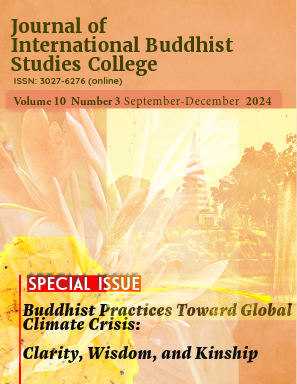The Practical Ways to Cope with Kilesa (Defilement) Based on Vatthupama Sutta in MajjimaNikāya
Main Article Content
Abstract
This study investigates ““The Practical Ways to Cope with Kilesa (Defilement) Based on Vatthupama Sutta In Majjimanikāya,” which encompasses three objectives: (1) To study the Concept and Nature of Kilesa according to the Buddhist Scriptures, (2) To study the Teachings Concerning the Ways to Prevent Kilesa according to Vatthupama Sutta, (3) To suggest Practical Ways to Cope with Kilesa and application to Daily Life. The research methodology of this study is a documentary analysis, utilizing document analysis and textbooks.
The findings reveal that kilesa are unwholesome mental factors, and their causes are ayonisomanasikāra and a lack of Indriyasaṃvara (Sense Restraint). The Vatthupama Sutta provides three kinds of recollection of the qualities of the three jewels and the four Brahmavihāras, which serve as effective preventive measures against kilesa. Drawing on this sutta, the application of mindfulness and the incorporation of the Noble Eightfold Path are suggested strategies for coping with kilesa. This integration method represents a practical way of coping with kilesa in everyday life.
Article Details
The Journal of TCI is licensed under a Creative Commons Attribution-NonCommercial-NoDerivatives 4.0 International (CC BY-NC-ND 4.0) licence unless otherwise stated. Please read our Policies page for more information on Open Access, copyright and permissions.
References
Barua, S. (2023). The development of Buddhist peace model for non-violence in modern society. The Journal of International Buddhist Studies College (JIBSC), 9(2), 91-113.
Bhikkhu Bodhi. (2010). The Noble Eightfold Path: Way to the End of Suffering. Buddhist Publication Society.
Bhikkhu Ñāṇamoli & Bhikkhu Bodhi (Trs.). (1995). The middle length discourses of the Buddha: A new translation of Majjhima Nikaya.
Bhikkhu Sujato (Tr.). (2023). Middle discourses: A lucid translation of the Majjhima Nikāya (Vol. I). Sutta Central.
Gethin, R. (1998). The Foundations of Buddhism. Oxford University Press.
Gunaratana, H. (2011). The Four Foundations of Mindfulness in Plain English. Wisdom Publications.
Janakabhivamsa, A. (2009). Abhidhamma in Daily Life. Corporate Body of the Buddha Educational Foundation.
Kornfield, J. (2005). Food for the heart: The collected teachings of Ajahn Chah. Simon and Schuster.
Mahāsi Sayadaw, Venerable. (1985). Brahmavihāra Dhamma (U Min Swe, Tr.). Buddhasāsana Nuggha Organization.
Mehm Tin Mon. (2002). Buddha Abhiddhamma: Ultimate science. Sukhi Hotu Sdn Bhd.
Mehm Tin Mon. (2004). Samatha (Higher level) (Vol. II). ITBMU.
Mehm Tin Mon. (2015). The Essence of Visuddhi Magga: The Noble Path to Eternal Bliss, Vol. II. Mya Mon Yadanar Literature.
Nandamālābhivaṃsa. (2012). Akusala: The nature of poison. Buddha Vipassana Meditation Center.
Nyanaponika Thera. (2005). The heart of Buddhist meditation: Satipaṭṭhāna: A handbook of mental training based on the Buddha's way of mindfulness, with an anthology of relevant texts translated from the Pali and Sanskrit. Buddhist Publication Society.
Pa-Auk Tawya Sayadaw & Mehm Tin Mon. (2009). Breakthrough in Samatha meditation and vipassanā meditation (2nd ed.). Yadana Min Literature.
Rahula, W. (1974). What the Buddha Taught. Grove Press.
Salzberg, S. (2017). Lovingkindness: The Revolutionary Art of Happiness. Shambhala Publications.
Sayādaw Sīlānandābhivaṃsa. (2014). Handbook of Abhidhammā studies (Vol. III). Buddhist Vipassana Meditation Society.
Suchart Abhijato. (2017). Against the Defilements: A Collection of Translated Excerpts from Dhamma Talks. Amarin Printing and Publishing Public Co., Ltd.
Suvinaya Bhikkhu, V. (2015). An Analytical Study of Āsava in the Theravāda Buddhism.
U Hoke Sein. (1981). The universal Burmese-English-Pali dictionary. Daily Gazette Press.
U Ko Lay. (Trans.). (1998). Māhavagga Samyutta: Large division. Department of the Promotion and Propagation of the Sāsana.
Ven. Javana-Huynh Minh Tanh, Ven. (2021). The role of pañña (wisdom) in eliminating kilesa (defilements) according to Theravāda Buddhist scripture. (Doctoral dissertation, Mahachulalongkornrajavidyalaya University).
Ven. Javana-Huynh Minh Tanh. (2021). The Role of Pañña (Wisdom) in Eliminating Kilesa (Defilements) According to Theravāda Buddhist Scripture. [Dissertation].
Ven. Mahāsi Sayadaw, (1985). Brahmavihāra Dhamma (U Min Swe, Trans.).
Ven. Mahāsi Sayādaw. (2013). The noble eightfold path in practice (U Htin Fatt, Tr.). Buddha Sāsanānuggaha Organization Mahāsi Translation Committee.
Ven. Suchart Abhijato. (2017). Against the Defilements: A Collection of Translated Excerpts from Dhamma Talks.
Ven. Suvinaya. (2015). An analytical study of āsava in the Theravāda Buddhism. (Thesis, Mahachulalongkornrajavidyalaya University).
Ven. Vajira. (2018). The Buddhist five precepts as an approach to promote moral values of people of Mahar Aung Myay Township, Mandalay, Myanmar. (Doctoral dissertation, Mahachulalongkornrajavidyalaya University).
Walshe, M. (Trans.). (1996). The long discourses of the Buddha: A translation of the Digha Nikaya. Wisdom Publications.


